Euphorbia rigida (syn. E. biglandulosa)
Unlike its rather dull brown rodent namesake, gopher plant (Euphorbia rigida) is beautifully colored, impressing with distinctive gray-blue, spiraling, lance-shaped leaves, chartreuse bracts, and bright yellow springtime flowers.
In some areas of its native range, this tough little evergreen is considered a weed and is unceremoniously ripped out of the ground.
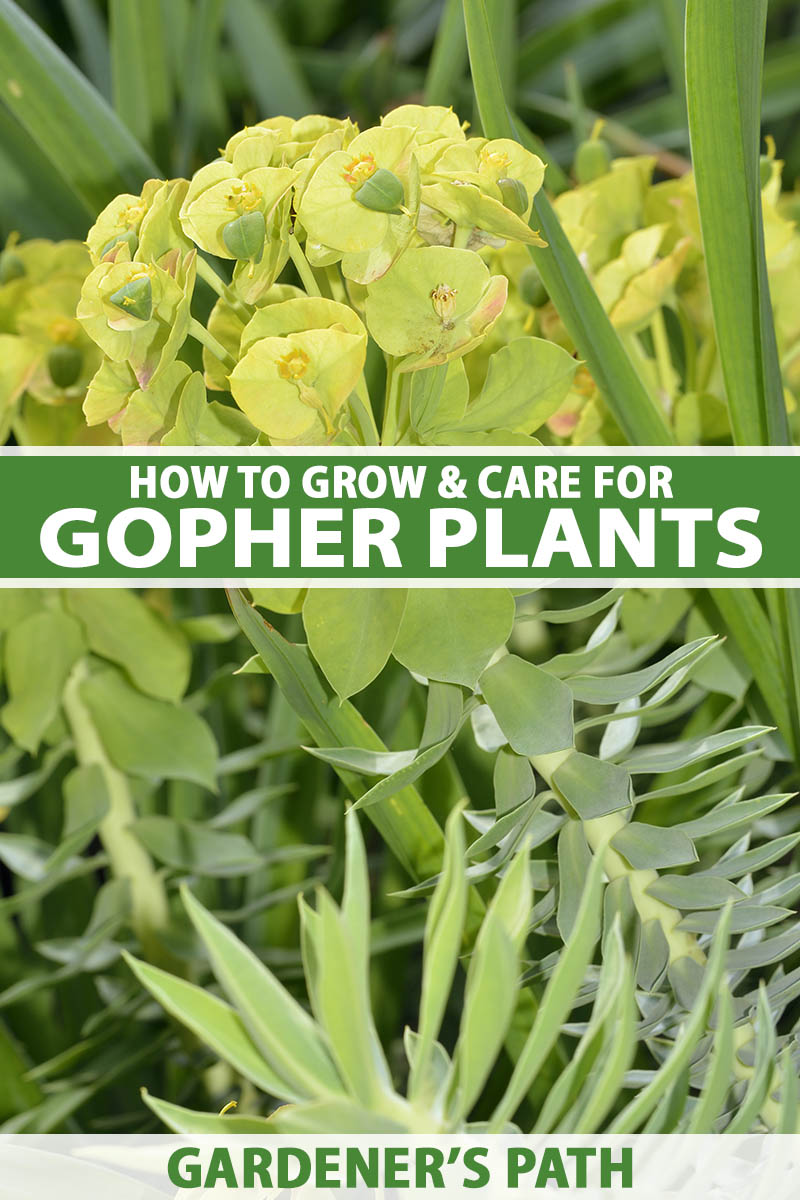
We link to vendors to help you find relevant products. If you buy from one of our links, we may earn a commission.
Fortunately, it has found a more welcoming home as a specimen ornamental in USDA Hardiness Zones 7 to 10 here in North America, where many gardeners appreciate its easy-care habit and striking appearance.
In cooler areas, many gardeners opt to use it as an annual.
If you need a happy container plant, a specimen for a rock garden, or something to fill your xeric landscape, you’ll see this evergreen at the top of many lists.
This shrubby, upright, sprawling, succulent-like plant has many aliases.
You may know it as upright myrtle spurge, silver spurge, rigid spurge, gopher spurge, or even milkweed. No, not that kind of milkweed (Asclepias spp.). This name comes from the milky latex the stem exudes when you cut it.
Just for good measure, it has a previous scientific name: E. biglandulosa.
Ready to start raising this marvel in your garden? Great, let’s go! Here’s what we’ll discuss:
What You’ll Learn
As with most spurges, this one is easy-peasy to grow. There are so few things that bother these plants. But there’s plenty to know about them, so let’s dig in.
Cultivation and History
Endemic to southern Europe, the Middle East, and southwest Asia, gopher plant is sometimes considered a weed in its native range.
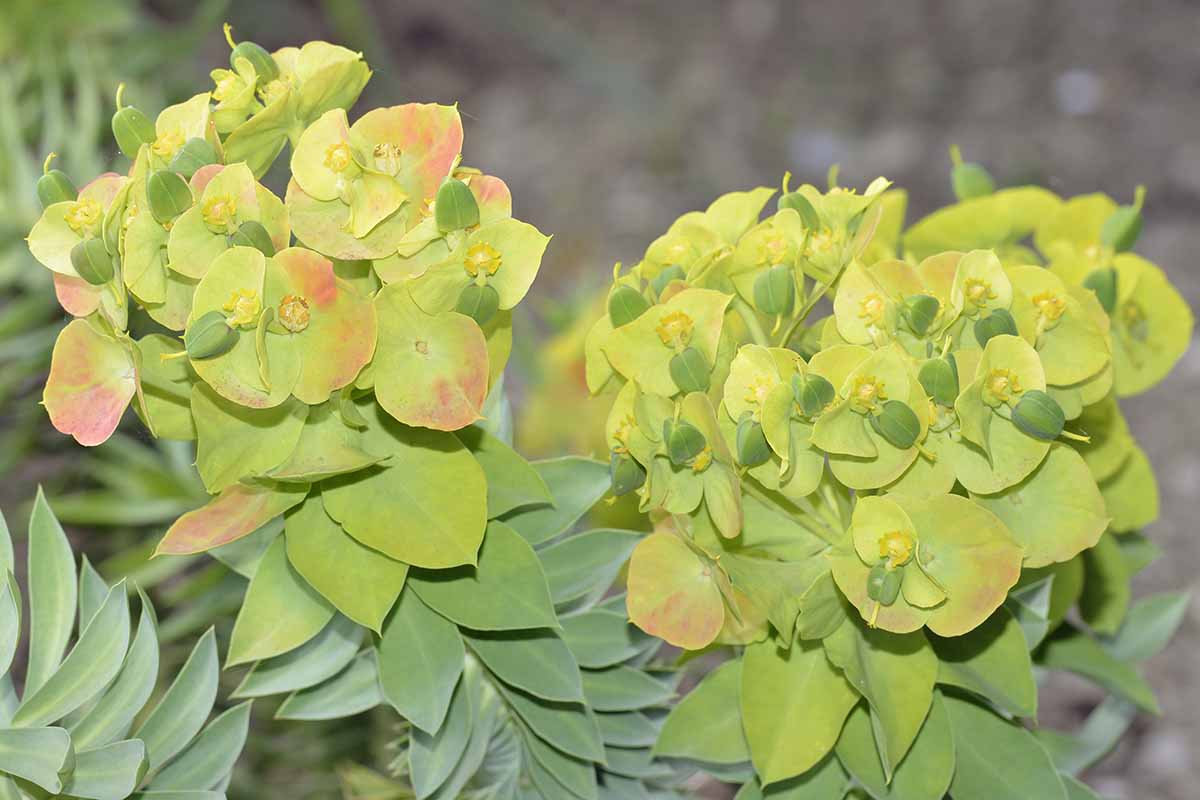
It has also naturalized in warm regions such as southern California. In North America and Europe, it’s a valuable ornamental for xeriscaping or gardens with rocky, challenging soil.
Bees flock to the yellow springtime flowers of this evergreen beauty, which is in the family Euphorbiaceae. The leaves are sessile, opposite, and can take on a reddish-bronze hue at the tips during the fall.
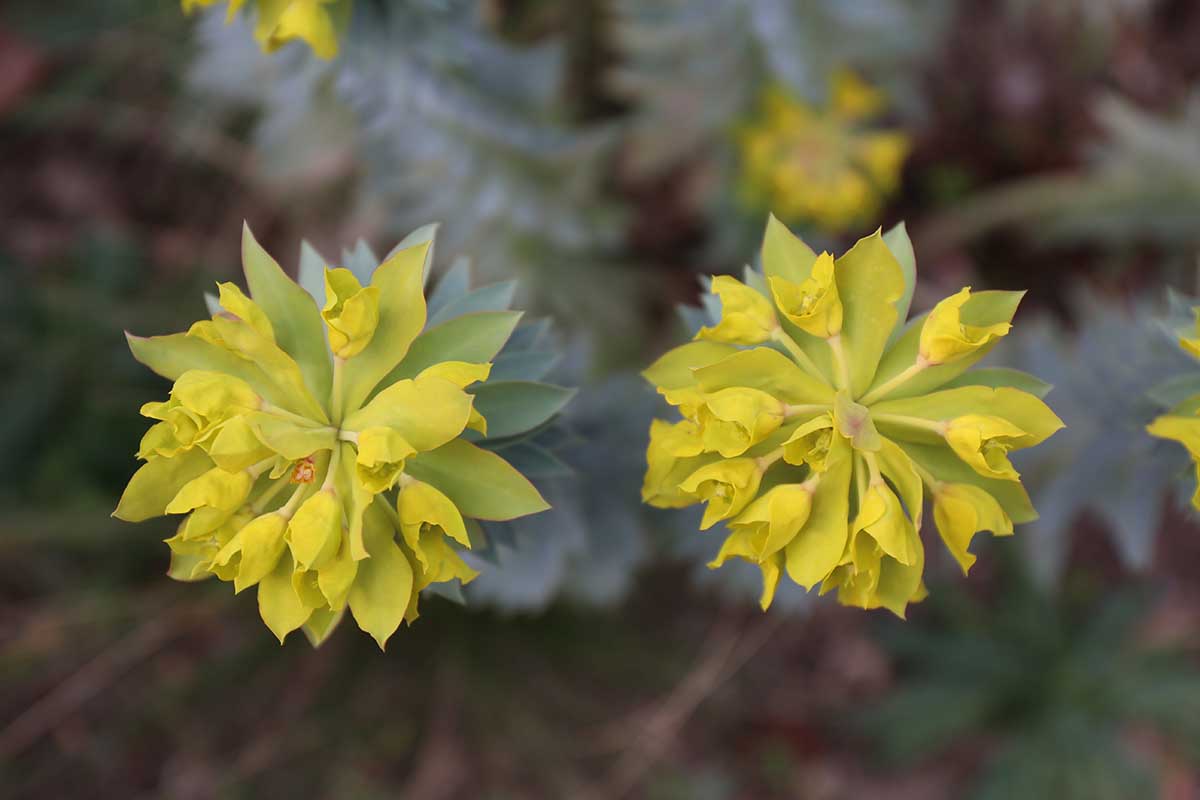
As alluded to above, this shape-shifter can sprawl out, almost ground-cover-like, or it can be much more shrubby, with silvery-gray, lance-shaped leaves that spiral around thick stems reaching up to two feet tall.
Sometimes a single specimen can exhibit both sprawling and upright growth habits. It will adapt based on the sun exposure, soil, and water availability. Talk about versatility!
These plants also tend to take on a more sprawling shape over time, particularly after blooming.
When mature, which can take anywhere from two to five years, a single specimen can reach up to three feet wide and two feet tall.
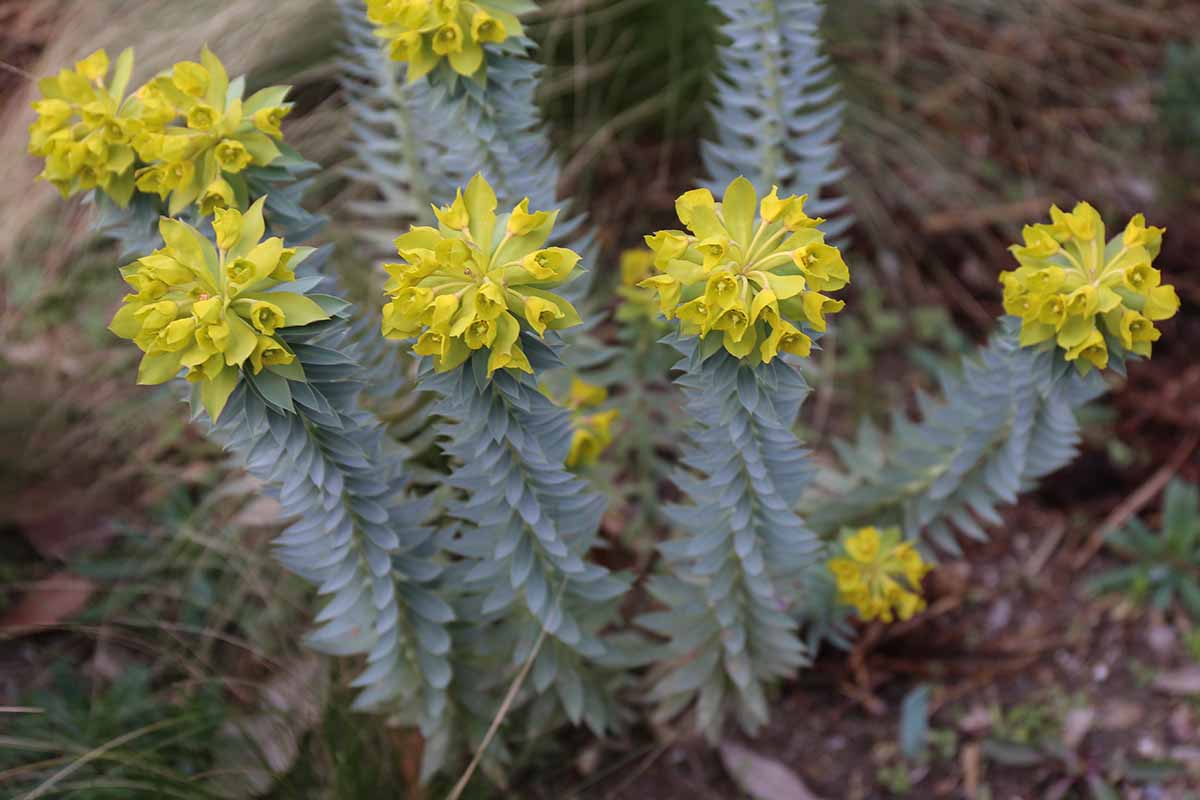
This species is cold tolerant to a minimum temperature range between 10 and 20°F. Gardeners in colder climates treat E. rigida as a summer annual.
Like its other Euphorbia cousins, E. rigida is toxic if eaten, so keep curious pets and toddlers away from this one. If a stem is cut or broken, it leaks a milky latex that can cause skin irritation in some people.
Scientists have begun research using various types of Euphorbia as a biofuel since they can grow in dry environments, need little water, and are vigorous growers.
I, for one, would love to be able to thank fields and fields of this pretty plant and its relatives for supplying electricity to my vehicle.
Gopher Plant Propagation
E. rigida seeds are not shelf stable, so it is unlikely that you will be able to purchase them commercially. When mature, gopher plant will self-seed in your garden.
From Cuttings
As the plant matures, it sends out lots of stems. You can cut off the end of one of these stems to propagate a new specimen.
In spring or summer, take nine-inch cuttings and remove all of the leaves from the bottom three-quarters.
Place the cuttings in a small pot filled with a cactus growing medium so they’re buried by about three inches. A six-inch pot is plenty big enough for three or four cuttings.
Water enough to moisten the soil but don’t make it soggy.
Place the cuttings in bright, indirect light and water when the top inch of soil dries out.
Keep them warm to encourage new growth – somewhere around 70 to 80°F is a good temperature to aim for.
Since many of us don’t keep our homes this warm, a heating mat placed under the containers can help.

This 10-by-20.75-inch mat from Vivosun that’s available via Amazon will speed up the rooting process and you can use it to raise seedlings like peppers and squash as well.
Your cuttings should be rooted in about three weeks. So long as they aren’t turning brown or wilting, they’re probably working hard under the soil to form new roots.
Allow them to remain in their containers throughout the winter, and then transplant them outdoors in spring. Before you set them in their new home, harden them off for a week.
To do this, bring the container outside and set it in a sunny spot for an hour. Bring it back inside for the rest of the day.
The next day, take the plants outside for two hours. Keep adding an hour per day for a week. Now you can transplant it in the garden.
From Divisions
As the plant ages, it will spread, and you can divide it. In fact, it’s a smart idea to divide your gopher plants to regenerate them since they don’t have a long lifespan.
Dividing gopher plants is a matter of digging them up by going around the perimeter of the clump and separating the roots to include a few stems.
Read our comprehensive guide to learn more about the dividing process.
Transplanting
If you live in a region where E. rigida thrives, you can probably find it at a local nursery. If so, putting it in the ground or a container is pretty straightforward.
Dig a hole in the ground about the same size as the growing container.
Gently remove the plant from the container and put it in the ground.
Fill in around the soil and water lightly. If the soil settles at all, add a bit more. The gopher plant should be sitting at the same height that it was in the pot or wherever it was previously growing.
How to Grow Gopher Plants
These hardscrabble toughies will tolerate many well-drained soil types: sand, loam, or chalk.
They look particularly nice in rock gardens and in beds with pebble mulch. Heavy clay probably drains too poorly, so grow in containers if this is what you’re dealing with.
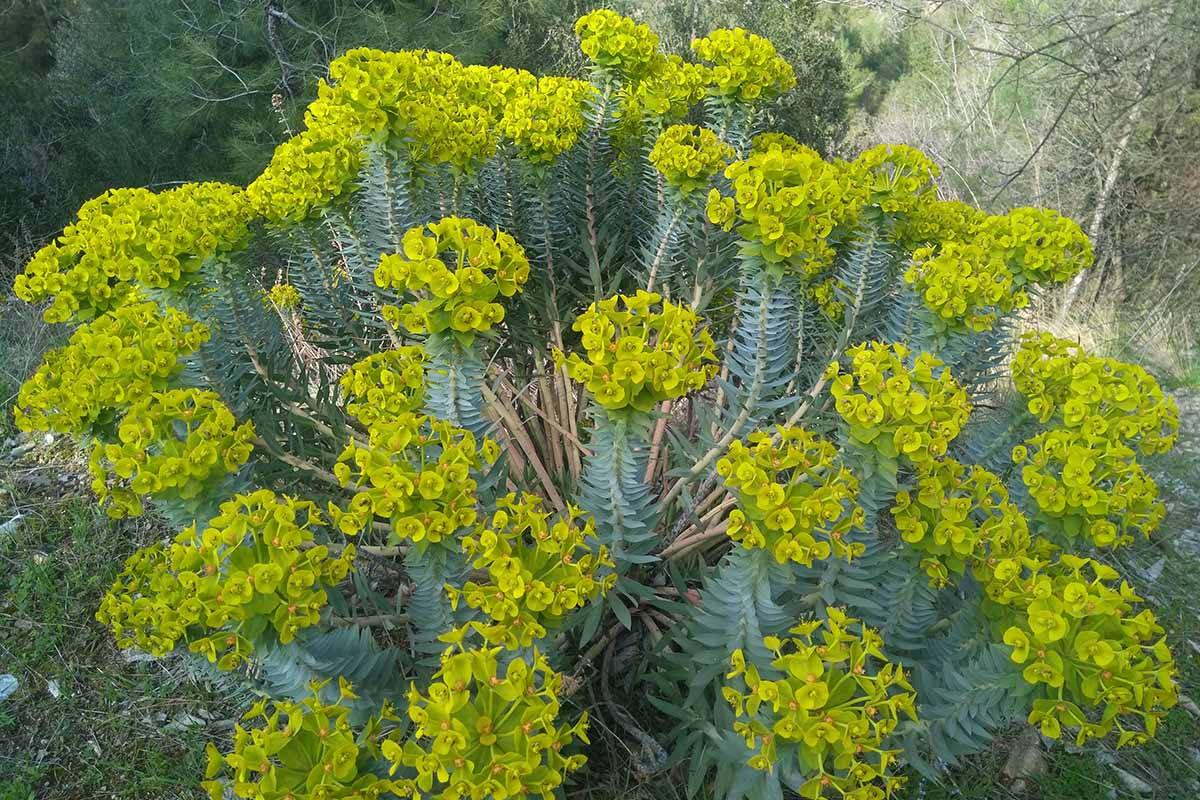
Gopher plants do best growing in full sun, and the canopy will have a more rounded, dense shape there. But you can also grow them in partial sun.
Additionally, they are extremely drought tolerant. I don’t give mine any supplemental water; we only get rain once or twice in the summer, and it does just fine.
If you see the plants start to droop after weeks and weeks of no rain, go ahead and give them a drink. Just don’t water so much that the soil turns soggy.
You absolutely don’t need to feed your gopher plants, but a side dressing of well-rotted manure in the spring won’t go amiss. Or you can feed with an extremely mild, balanced fertilizer.
I like Down to Earth’s Vegan Mix, which has an N-P-K rating of 3-2-2. It’s perfect for cacti and succulents that need a boost.
Arbico Organics carries this fertilizer in five-pound compostable boxes.
Containers
As we said, the gopher plant is perfectly happy in containers. Make sure to select a pot that has good drainage, with at least one hole per gallon of capacity.
Terra cotta is a smart option because it dries out more quickly than other materials, but anything with good drainage will work.
Don’t fill it with a standard potting soil. Choose a succulent or cactus-specific medium. Water only after the soil has dried out completely.
Growing Tips
- Grow in any well-draining soil.
- Grow in full to partial sun.
- Water if there hasn’t been any rain for several weeks.
Maintenance
The yellow flowers inside the chartreuse bracts turn orange as they mature, and the sepals change from green to a reddish hue.
Eventually, green fruits form. If you want to prevent self-seeding, cut off the flowers once they turn orange.
If you object to the sprawling, slightly odd-looking form that gopher plant can take on after blooming, trim off the trailing stems. You’ll get a more compact, upright growth habit this way.
Wear gloves while you’re at it, though. You don’t want that sap-like latex to irritate your skin. Otherwise, these plants require no further maintenance.
Gopher Plant Varieties to Select
There aren’t any cultivars on the market, but you can find hybrids that use E. rigida as a parent.
Shorty (E. x ‘Shorty’), for instance, is compact and stays under 18 inches tall, with bronze and green leaves.
Managing Pests and Disease
E. rigida repels deer and rodents, including – you guessed it – gophers, so there’s no need to fret over those pests.
There’s really just one type of insect pest that might attack your plant from time to time, though it’s usually found only on those that are stressed.
Red Spider Mites
Red spider mites (Tetranychus urticae) are common pests in dry, hot conditions.
If they find and feed on your plant, you’ll see yellow stippling and fine webbing on the leaves. If you look closely, you’ll also see tiny red dots moving around the foliage.
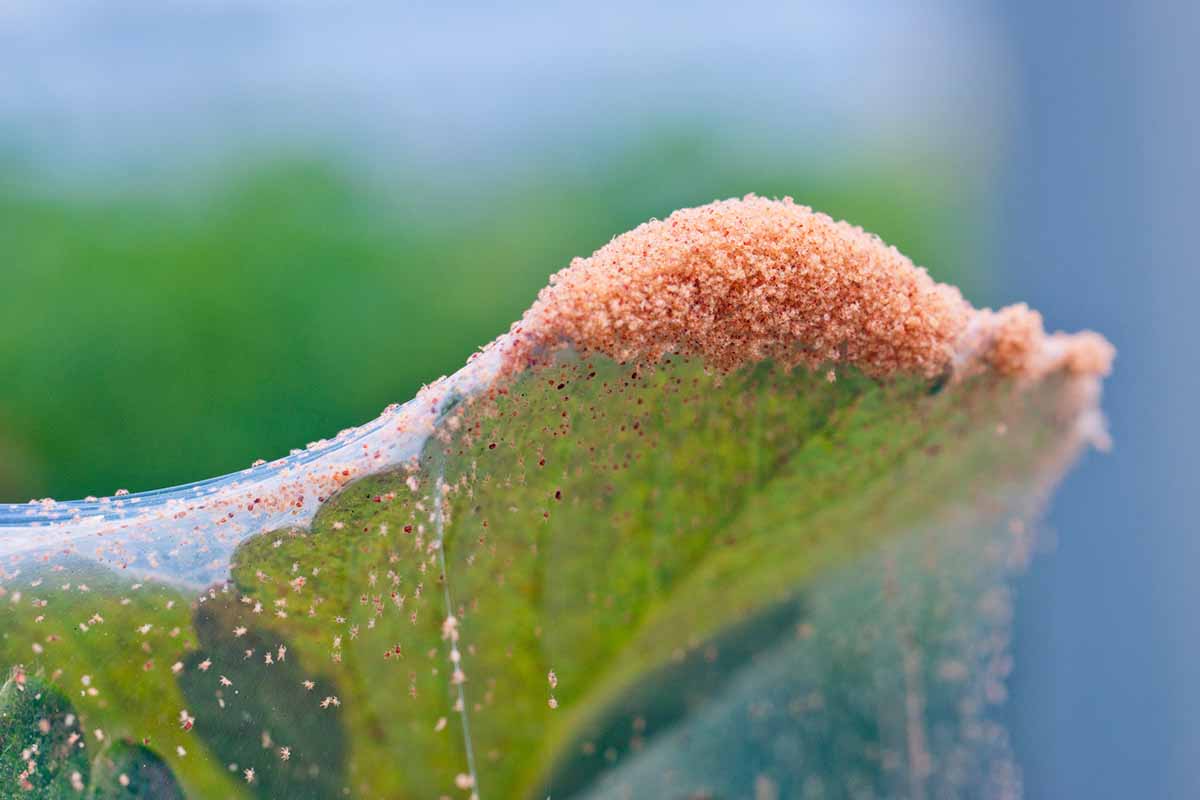
To get rid of red mites, pour room-temperature water on your plant to knock them loose. Do this every few days until the infestation is gone.
Don’t do it for too long, though, or you’ll run the risk of drowning the roots or introducing disease.
Speaking of which…
Disease
If you’re growing your gopher plant in dry conditions and well-draining soil, you probably won’t ever have to deal with diseases. If it’s wet or poor draining soils, you might see the following:
Powdery Mildew
Powdery mildew appears as small spots of white, powdery growths on the leaves.
It’s usually no more than a cosmetic issue, but severe cases can kill off some of the leaves and cause stunted growth.
Powdery mildew is caused by fungi in the Erysiphales family, which thrive in warm, dry weather on plants that are crowded or in too little light.
Read our guide to powdery mildew to learn how to address this problem using homemade methods.
Systemic fungicides don’t work well because Euphorbias have periods where they don’t take up water, so they wouldn’t take up the fungicide either at that time. Topical treatments are best.
Root Rot
Root rot in upright myrtle spurge is often the result of the roots drowning in too much water rather than being caused by a pathogen.
The roots turn mushy and black, and the top of the plant wilts, turns brown, and sags to the ground.
Once that happens, it can’t be saved. But if you catch it early, you can replant in a better area or change your watering schedule.
Occasionally, wet conditions can lead to an infection by fungi in the Fusarium genus.
This type of rot usually happens to specimens that are already stressed. It has the same symptoms whether or not it’s pathogenic, so it’s really hard to tell if it’s the fungus at work or the drowning roots that are causing the issue. Best to treat for both.
If the soil doesn’t drain well, the first step is to replant somewhere where it is. Next, prune out any brown foliage. Finally, treat with a fungicide that targets fusarium, such as Mycostop.
This is my go-to for root rot because it’s both effective and you don’t have to wear a hazmat suit to avoid chemical fallout when you use it, since it’s made with a beneficial bacterium – Streptomyces strain K61 – derived from sphagnum moss.
Arbico Organics carries Mycostop in five or 25-gram options. Apply it as a soil drench, not as a spray, following the manufacturer’s directions.
Best Uses for Gopher Plants
I dare you to find a better option if you need a carefree container plant, or a specimen to add color and texture to a rock garden.
If you need something to fill your xeric garden, E. rigida is a sure winner!
Quick Reference Growing Guide
| Plant Type: | Evergreen spurge | Flower/Foliage Color: | Yellow/green |
| Native to: | Europe, Middle East, Southwest Asia | Maintenance: | Low |
| Hardiness (USDA Zones): | 7-10 | Tolerance: | Drought, frost |
| Bloom Time: | Spring blossom, evergreen leaves | Soil Type: | Sandy, loamy |
| Exposure: | Full to partial sun | Soil pH: | 6.0-8.5 |
| Time to Maturity: | 2-5 years | Soil Drainage: | Well-draining |
| Spacing: | 18 inches | Attracts: | Pollinators |
| Planting Depth: | Same depth as growing container or previous growing depth (transplants) | Companion Planting: | Succulents |
| Height: | 2 feet | Avoid Planting With: | Moisture-loving plants |
| Spread: | 3 feet | Order: | Malpighiales |
| Growth Rate: | Moderate | Family: | Euphorbiaceae |
| Water Needs: | Low | Genus: | Euphorbia |
| Common Pests and Disease: | Spider mites; powdery mildew, root rot | Species: | Rigida |
The Perfect Plant for Challenging Spots
Texturally and chromatically compelling, easy to care for, and it repels rodents — what more could you ask for?
E. rigida is an attractive plant that does particularly well in xeriscaped landscapes or other gardens where an intriguing specimen would be welcome.
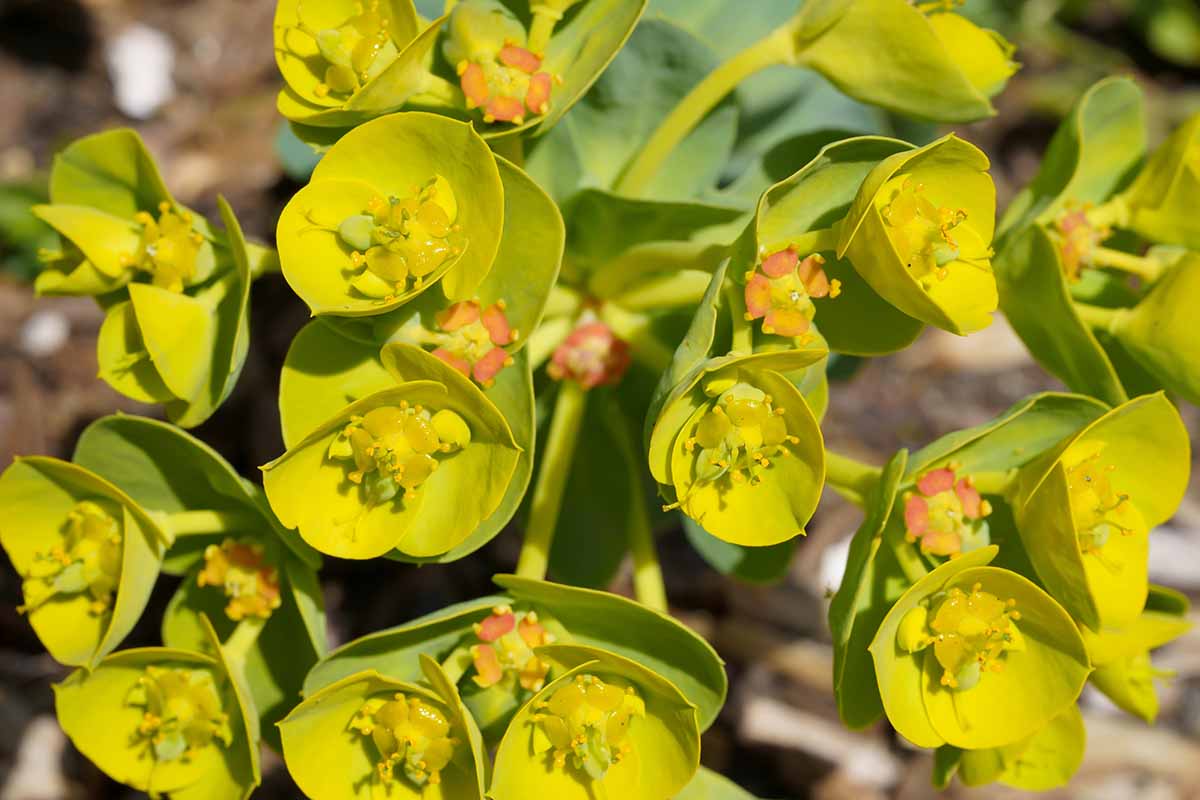
Had you ever heard of E. rigida before reading this guide? Does it sound like something you might like to add to your garden? How do you think you’ll use it? Tell us about it in the comments section below.
Now that you’ve got the gopher plant situation under control, maybe you’re looking for some others to add to your xeric garden. If so, here are a few guides that might be helpful:
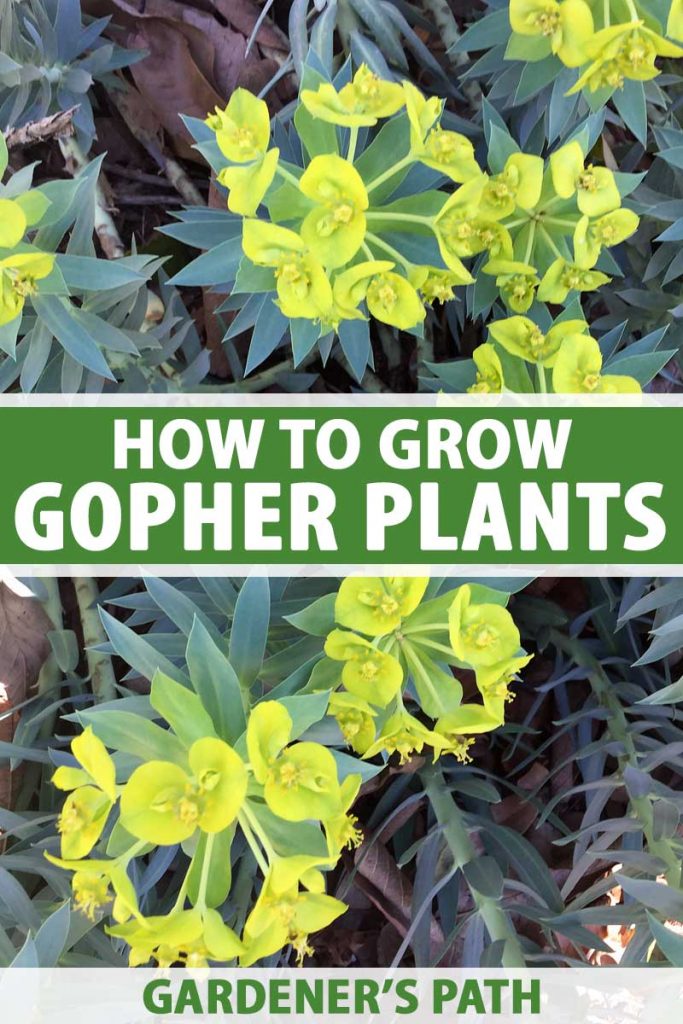
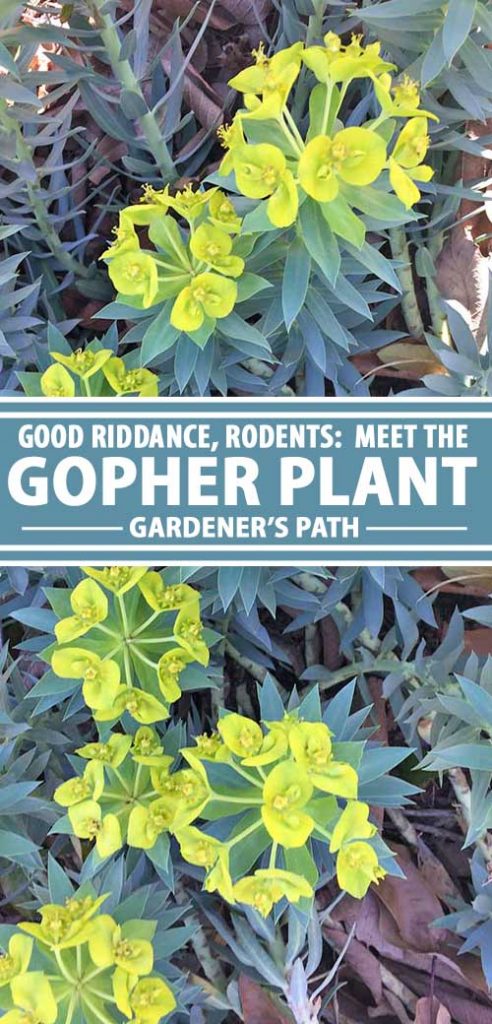
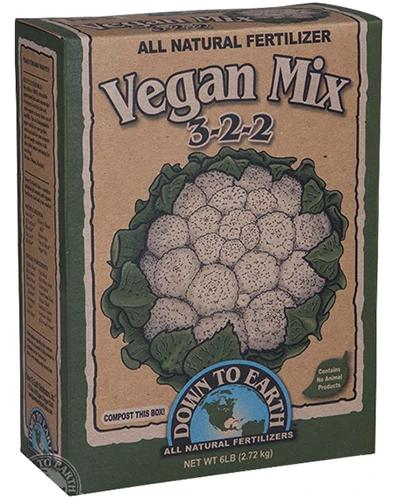

I bought my gopher plant in Albuquerque, but I brought it up to Brookfield, Wisconsin which is where I live. What are the chances it will survive our winters? Should I plant it in a pot? That way I can take it inside when winter comes. Please advise…
Gopher plant isn’t likely to survive in the ground in USDA Zone 5b, which is Brookfield’s zone. A pot is probably your best bet for keeping it alive. Use something that is about 2 feet wide and a foot deep. Because it’s likely to be heavy, you might want to put the container on a wheeled base. Indoors, it either needs a spot in direct sunlight for at least 6 hours, or provide it with supplemental light. Be sure not to overwater.
Where can I get 0.1% naphthalene acetic acid?
Can I use something with the active ingredient Indole-3-butyric acid instead?
When is the best time to transplant these? We live in St. George, UT in zone 8.
My gopher plant looks like it’s dying! This is the 3rd one that’s turned yellow. I cut back old growth and it revived. Ground is moist and plant is near the house with full pm sun.
Is 12 minutes on drip every other day too much water?
Hi Diane, my guess would be that your plants are receiving too much water. Gopher plants are drought tolerant and prefer not enough water over too much. They also prefer eight hours or more of sun. If they aren’t receiving this much sun, they usually need even less water. Try reducing the amount of water you’re giving it and see if that helps.
Yes, sounds like too much water.
I live in southern Arizona and water mine about once a month! You are giving yours WAY too much water.
Skin irritant? Yes. My husband Transplanted a gopher plant plant and then touched his eyes . He had to flush his eyes out for 15 minutes in the shower. And he suffered all day.
Oh no, Monica! That sounds awful! Noted: don’t touch a gopher plant and then touch your eyes.
How do I kill my gopher getter plants! I’m extremely allergic to them
Oh dear, it sure looks that way. Pulling them is the best way to go, but you might want to hire someone or enlist the help of someone who isn’t allergic. Alternatively, you can spray the plants with glyphosate but take extreme care only to saturate the plants you’re trying to kill.
From East Dallas, TX in Zone 8 on May 24, 2024. (3 paragraphs). Hola Kristine and thank you for your article on Euphorbia Rigida, this year’s favorite plant of mine and a bit of an obsession 🙂 as there are not many articles on it. Any specific advice for propagation via seed? I have been collecting seeds with my neighbor’s permission. Previously three cuttings (carefully followed instructions) died a few days after transplant, one never rooted. Previously also, we transferred a whole unit from sunnier next-door neighbor’s downhill west-facing front-yard to our flatter almost-as-sunny west/sw facing front-yard surface: the plant… Read more »
Hello fellow E. rigida lover! Isn’t it annoying how a weedy plant can suddenly become delicate the moment we want to propagate it?! How fortunate that you were able to obtain seeds. You should plant them within in six months to ensure germination, though they might store a bit longer in a cool, dark place. To plant them, place the seeds about a quarter inch deep in potting soil or a seed starting mix. Either works. You can use a seed tray or small individual pots (three or four-inch pots). Keep them in temperatures between 50-70F in bright, indirect light.… Read more »